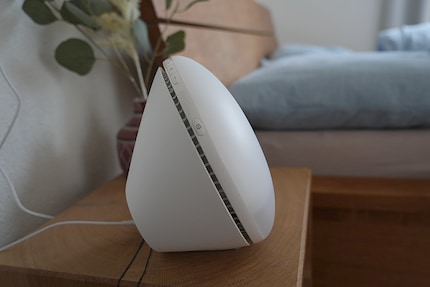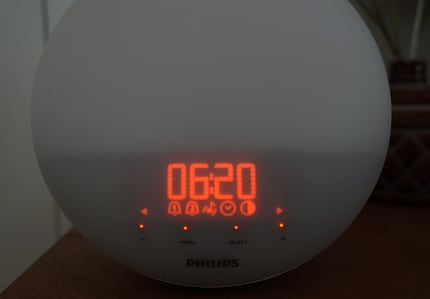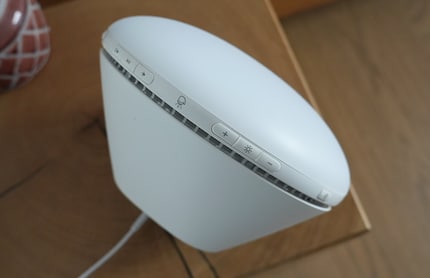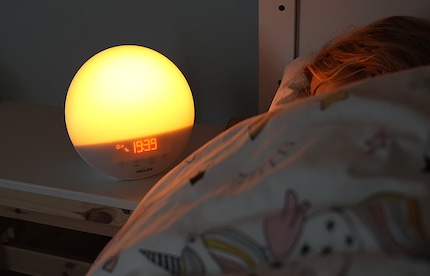

Philips SmartSleep Wake-up Light – sleeping with the enemy
I had one goal: to start the day more refreshed. In my thoughtless trance of fatigue, I bought the Philips Wake-up Light. It’s found a use in my family – just not by me. And not as an alarm clock.
I guess I’ve joined the ranks of influencer victims. And it didn’t even take much to convince me. A well-known Swiss content producer recently raved about a Philips light alarm clock in her Instagram story, emphasising she’d paid for it out of her own pocket – and bang, the very same model landed in my Galaxus shopping cart. I’m not typically one to spend over a hundred francs so quickly and thoughtlessly. But after my kids gifted me a few sleepless nights, the idea of getting – nay, floating – out of bed, totally well rested and relaxed, was just too tempting.
Let’s put it this way: the influencer found me at the right time and place. With that, the Philips SmartSleep Wake-up Light HF3519/01 (that’s its official name) has been in my bedroom for a few weeks now. And guess what ...
Boy, does it drive me up the wall. Deep relaxation? I wish! And yet, the device wasn’t a bad buy. The light alarm clock has since proved itself in another role. Namely, as a sleep aid for my daughter. But let’s start at the beginning.

Futuristic sphere takes up residence on my bedside table
My first case of disillusionment rears its head upon unpacking the alarm. I knew it wouldn’t exactly be the pinnacle of beauty, but I hadn’t realised just how massive it was. In the spur of my tired-eyed spontaneous purchase, I’d ignored the product dimensions. Now I’m forced to clear my nightstand before I can even squeeze the thing on there. The futuristic sphere tapers at the back to form the stand. It was probably meant to simulate the sun – but couldn’t that have been achieved one size down just as well?

Source: Katja Fischer
Alright, alright. They do say it’s what’s on the inside that counts. I’ll keep an open mind. After all, the selling point isn’t the design, it’s the alarm function. Instead of the typical noise an alarm clock makes every morning, the Wake-up Light from Philips uses light to get you up – by simulating a sunrise. The light gradually grows brighter, and «the colour of the morning light changes from soft dawn reds through warm orange to bright yellow light», writes the manufacturer. This is supposed to give you a slow, gentle, and natural wake-up – no app or Wi-Fi needed. Your body’s melatonin level, which is affected by light, decreases, while the cortisol production is slowly boosted.
Because this gentle light impulse alone typically isn’t enough to wake you, you can choose an alarm tone to go with it at a specified time – a relaxing sound, of course, like the sound of the sea or of Tibetan singing bowls. Unfortunately, there are only five sounds to choose from. There’s also an FM radio function, but I’m ignoring it for now. Radio alarm clocks have never been my cup of tea; I’m not ready for musical surprises in the early morning.
For the first morning, I go for the fake sunrise accompanied by birdsong. After a bit of clicking around, I get the hang of the controls. I can set two alarm profiles, for example, one for workdays and a second for weekends. But I’ll limit myself to just one for now. I set the wake-up time, light intensity and volume of the birdsong. I also have the option of modifying the duration of the sunrise, that is how long it takes for the light to reach the set intensity, after which the birds start singing. By default, the sunrise time is 30 minutes. I’ll leave it as is.

Source: Katja Fischer
Just to be on the safe side, I do also set the alarm on my phone. Fortunately for me, as I’d find out in just a few hours. The light didn’t start up at 6 a.m. as expected, and the birds, too, remained silent. What happened? Well, I’d set everything up but forgot to actually turn on the alarm.
Teething problems with the birds
The next morning, it works. The sunrise begins at 6 a.m. sharp, and at 6:30 a.m. birds are chirping into my ear. The thing is, they could have spared me their whistling; I’ve been wide awake in bed for half an hour anyway. On my phone, I’d typically hit snooze repeatedly, dozing off in between. Now, I stand no chance of getting any light shuteye in the dimly lit room. The light alarm clock also has a snooze function – I just have to give the top a tap with my hand. However, this only interrupts the sound. The light stays on. And me? I stay wide awake – and just as dead tired.
It’s time I did some fine-tuning. In the same alarm profile, I reduce the light intensity by a few levels and lower the sunrise time from the default 30 minutes to 20 minutes (less isn’t possible) to extend my sleep time by a bit. And I tell myself that it’s all a matter of habit; that my body simply isn’t used to dozing off in fake sunlight and will learn to do so.
Resistance is stirring in the conjugal bed
Spoiler alert: days later, my body still hasn’t acquired this skill. Every time the light comes on – no matter how soft – I practically jump up in bed. My first course of action is to frantically try to turn off the alarm clock.
But that takes several hand manoeuvres and costs some serious nerves; I have to turn off the alarm and the light separately ... and then reactivate the alarm for the next day. In addition, the buttons are impractically located right on the edge of the alarm clock. To press them, I have to hold down the alarm clock to stop it from tipping over. Time and again, I hit the wrong button and accidentally turn on the light or radio.
Not really an enjoyable experience so early in the morning. Holy smokes, does it make me mad. With no trace of relaxation left, I feel even more exhausted than usual. The fact that I have to reprogram all my settings several times because I unplugged the Wake-up Light is the cherry on top.

Source: Katja Fischer
Alarm clock, you’re really getting on my nerves. This is your last chance. I now set things up so that the sun only starts rising when I want to actually get up: light on at 6:30 a.m., birds on at 6:50 a.m. But like this, there’s no question of me staying in bed at all, meaning I miss out on the birds entirely. I suppose the clock works like this ... but a gradual, gentle wake-up it is not.
Third-party resistance is now also mounting. My husband let me have my fun for a few days without comment, but now he’s starting to file his complaints. He was quick to make fun of the giant globe on my bedside table. But he doesn’t find it funny anymore. Sure, the birds may stay silent, but all the other hubbub annoys him at least as much – and the fake sunrise even more.
What can I say, I guess we’re just not sunrise-y people.
Sunset to the rescue!
Put differently, I suppose we’re simply more sunset-y people.
Let’s not forget: the Wake-up Light also has a feature for falling asleep. I’ve decided this better fix things. Instead of being woken up by the sunrise, I want to be put to sleep by the sunset. I can set it to span anywhere from 5 to 60 minutes, during which the light gradually decreases in brightness until it goes out completely.
To start, I select the default setting of 30 minutes coupled with a relatively high light intensity. Like this, the Wake-up Light functions like a bedside lamp; I can still read my book for about a quarter of an hour without issue. After that, the light is too dark, so I put down my book and enter sleep mode.
I’d like to hear the soothing sound of the sea at this point. Unfortunately, that’s only an option in alarm clock mode. In falling asleep mode, I can only turn on the FM radio. I’m sorry, but in what world is the radio a gentle accompaniment to slipping into a serene slumber? As I’m lying in bed, thinking about how nonsensical this is, I notice my eyelids getting heavier ... and wake up again the next morning to my phone’s alarm clock.
The trick to falling asleep
I like the sleep function. I want to test it on my six-year-old daughter who tends to struggle with falling asleep. I use a trick to get the Wake-up Light to do what I want. Namely, I misuse the alarm clock function for falling asleep so that my daughter can have nature sounds in the background.
I set the alarm – or rather, sleep sound – to go off in one minute and set the light to the lowest level. This leaves the Wake-up Light no time to go through its minimum sunrise duration, so both the light and birds start up simultaneously. This seems to be the perfect combo for my daughter. Within a few minutes – before the light has become garish – she’s entered the land of dreams. Success! Mind you, I do then have to turn the Wake-up Light off by hand.

Source: Katja Fischer
This trick for falling asleep is proving a real game-changer. My daughter now almost exclusively wants to fall asleep with the light on and with the gentle background noise. With that, the Philips SmartSleep Wake-up Light has found its place in our family – though not the one originally planned.
My verdict: not for me, but maybe for you
The alarm’s warm light jolts me out of my dreams most rudely. It’s just not for me. But that doesn’t mean it’s a bad device. I’ve read numerous positive reviews and enthusiastic comments. That’s why I say that if you like to be woken up by a simulated sunrise, the Philips SmartSleep Wake-up Light may be just the thing for you. But if, like my daughter and I, you use it for its falling asleep function only, it’s too expensive.
Pros:
👍 The device is simple and intuitive to use.
👍 You don’t need an app or Wi-Fi.
👍 You can program two alarm modes.
👍 You can use it as a reading lamp.
👍 It has an easy-to-activate snooze function – just give the clock a tap. But, the light remains on when snoozing.
Cons:
👎 The alarm clock is bulky and takes up a lot of space.
👎 To turn it off, you need to give two inputs; the light and sound are turned off separately.
👎 The buttons are awkwardly positioned on the side. You have to hold down the clock to operate it.
👎 There are only five nature sounds to choose from. And they’re only available in wake-up mode.
👎 The device needs a nonstop power supply.
Mom of Anna and Elsa, aperitif expert, group fitness fanatic, aspiring dancer and gossip lover. Often a multitasker and a person who wants it all, sometimes a chocolate chef and queen of the couch.


